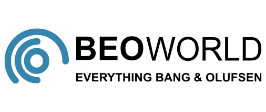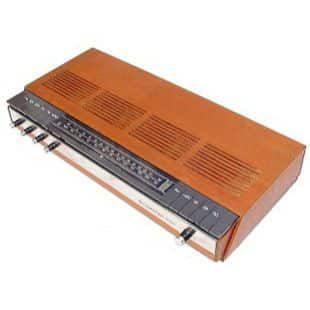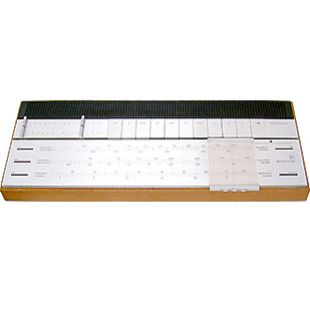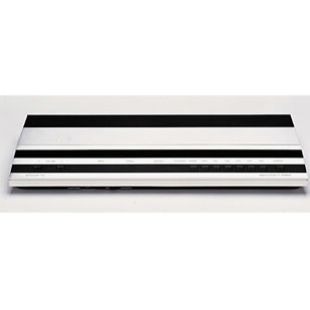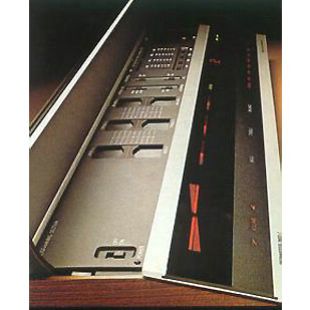BeoSound 9000
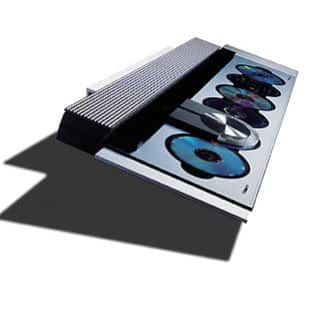
BeoSound 9000 makes a strong statement with your music – but leaves it up to you to decide exactly how.
Music may not be essential to life, but it’s hard to live without it. That’s why BeoSound 9000 makes such a big thing about bringing your music out into the open and letting you create your own personal jukebox with the music that means the most to you. Combine BeoSound 9000 with the latest Beolink® PC 2 software application and you can access the digital music files on your computer’s hard disc. Place it upright in a bookcase, lay it flat on a shelf, or hang it directly on the wall – either vertically or horizontally. It can stand between a pair of BeoLab 1 or BeoLab 8000 loudspeakers, or with any other speaker in the BeoLab range. With BeoSound 9000, the possibilities – and the enjoyment – are endless ” (B&O Catalogue 2001 – 2002)
BeoSound 9000 represents the latest technology from Bang & Olufsen today. The 6-CD changer is the fastest in the world. If allowed to continue its momentum it would travel 100km/h in just 5,5 seconds… faster than a Ferrari from a stop position! It can be positioned in several different ways and the display text automatically adjusts itself to be readable. The unit too features a FM/AM tuner with RDS and is equipped with the new MasterLink connections and can be connected directly to the Beovision Avant and AV9000.
The CD returns to its original position
The discs are easily loaded and held by spring suspended jaws. Discs not in play can be replaced without interrupting the playback. The auto-positioning feature ensures that CDs are always returned to the position in which they were first placed. With the CDs visible and positioned correctly, there is easy access to the text information printed on the label. The glass-covered natural aluminium plate holds the CDs and the rails for the CD carriage, while a backlit acrylic plate illuminates the CD currently playing.
Glass cover to counteract gravity
BeoSound 9000 offers unprecedented flexibility for a product of this type, and to ensure the same uniform movement of the glass cover regardless of the placement of BeoSound 9000 vertically or horizontally, upright or flat. To counteract the effect of gravity, a digital time control constantly monitors the movement of the cover and adjusts the motor, keeping the complete movement within 3.5 and 4 seconds.
Safety first
Such an abundance of fast moving mechanics means that special measures have been taken to ensure that BeoSound 9000 is safe to operate. Small prismatic lenses are placed at each end of the aluminium frame, controlling an infrared beam across the front of BeoSound 9000. If the beam is violated, the CD clamper will stop immediately.
If the glass door is lifted while the clamper is in motion, it will decelerate immediately. A power failure feature ensures that the clamper is not damaged in a gravitational free-fall, if BeoSound 9000 is mounted vertically.
Ingenious engineering solutions and intricate mechanical movements in a product that continues to surprise and delight users today – and all this from the inspiration of old vinyl records spinning on the record player’s turntable.
The unit may be played in one of seven different positions. In each one, gravity has a different effect on the CD clamper (the aluminium ‘arm’ which rests over each CD when it is being read), yet it still works with the same precision and speed: a good example of how Bang & Olufsen uses technology to overcome acceptable limitations. Place BeoSound 9000 upright in a bookcase, lay it flat on a shelf or hang it directly on the wall – either vertically or horizontally. It can stand, for example, between a pair of BeoLab 1 or BeoLab 8000 loudspeakers (as above), or with any other speaker in the BeoLab range. With BeoSound 9000, the possibilities – and the enjoyment – are endless!
BeoSound 9000 starts with the technical excellence of the CD, but moves on from its limitations. A couple of good old-fashioned mechanical virtues make a welcome comeback. You can see it work and understand how it reacts when you touch its buttons. Or you can sit back with your Beo4 remote control and browse through over 7 hours of musical pleasure.
BeoSound 9000 makes a virtue of displaying the features that so many manufacturers try to hide away” welcoming the user with open arms to use it.
Features
BeoSound 9000 works so fast and so quietly that the change-over between two CDs seems no longer than the normal interval between tracks. Using the inaudible initial lead information on the discs, each CD can be named and memorised, and will be left in the same position as it was loaded, with its title clearly legible. Enter up to 200 titles in the memory and they’ll appear on the display whenever one of those CDs is played.
The FM/AM radio has memory for up to 60 stations which can be identified by their names instead of their frequency numbers. Set the timer and wake up to your favourite programmed CD sequence or radio station.
The fine art of control of BeoSound 9000
Lift the lid on BeoSound 9000 and the extensive control panel with timer, editing and sound adjustment operations is at hand. Since the BeoSound 9000 can be placed in a great number of positions, the control panel can turn as you prefer. The display follows the same orientation, of course!
Auto Positioning
Auto-positioning was one of the challenges that Bang & Olufsen’s engineers had to meet because of BeoSound 9000’s clear versatility in placement. Using the inaudible initial lead information present on most compact discs, the BeoSound 9000 is able to detect and memorise a desired position for the CD.
When it’s time to stop the CD, a servo system decreases the speed of rotation, the position mark is detected, and this effects the final braking and halt. A servo calculates the braking length for the CD, processes and stores the information. So the next time the CD will stop even faster, because BeoSound 9000 now knows where and when to apply the brakes. A total of 360 perforations ensure that your CD will stop precisely at the point at which you placed it in the rack.
The secret behind the precision of the movable clamper lies in two sensors which monitor its exact position and speed more than 60 times a second, and in its digitally-controlled motor, which compensates for even the slightest variation in movement.
Note: For owners of BeoSound 9000 who wish to use BeoLab 5 with this particular CD player, another feature of these new active speakers will be a direct digital feed from the optical output of BeoSound 9000 – the output not used at present!
BeoSound 9000: an evolutionary movement
Since the early days of the gramophone, record changers have been known and appreciated for their long playing time. The modern version of the record – the CD – adds a new perspective to the old old idea.
In designing BeoSound 9000 from scratch, a number of design models were created in order to illustrate various ideas.
The ‘library machine’ was one of them. It could hold an entire CD collection ready for playback. However the stored discs disappeared out of sight into the innards of the machine. This was seen as a problem because compact discs are not able to give a readout of a library’s contents, making an automatic catalogue display impossible, and since the design group felt a primary manual entry of all CD data was out of the question, the idea was quickly abandoned.
In returning to square one, the dominating feature – as in a CD changer – is the ability to play continuously for a long period of time. In coming up with a solution for this problem, together with presenting visual feedback, the discs were placed with their covers upwards and in a line next to each other, protected, under a lid of transparent glass. This was the main idea behind the very first design model of BeoSound 9000.
However, David Lewis, as Bang & Olufsen’s chief designer presented the first design model of BeoSound 9000 in two editions: the one which we know today with its 6 CDs, as well as another model comprising ten compact discs laid out in a line next to each other (see picture above).
The design group liked the 10-CD edition; it looked stunning, but in use it was limited to just once placement (unlike the eight different placements that the currently-produced BeoSound 9000 offers). The 10—CD version was subsequently shelved with the 6-CD version going into production in 1996.
David Lewis’ BeoSound 9000 from 1996 makes a virtue of showing its function. It clearly displays, by the 6-CD slots, that its function is the playing of music It can be placed horizontally on a wall or vertically on a special column when it becomes almost a sculpture for the home. Like B&O’s other products BeoSound 9000 contains the most advanced techniques around but shies away from technical mystique with its interface being simple and self-explanatory.
Control
Lift the lid on BeoSound 9000 and the extensive control panel with timer, editing and sound adjustment operations is at hand. Since the BeoSound 9000 can be placed in a great number of positions, the control panel can turn as you prefer. The display follows the same orientation, of course. BeoSound 9000 may also be controlled by the optional Beo4 remote control.
Placement
On the optional bracket, the BeoSound 9000 displays itself raised at an angle, or standing tall. Attach it horizontally and watch all the CDs stop in exactly the same positions as they were loaded in. Or you might opt for the floor stand as a bold musical statement. Hang BeoSound 9000 vertically on the wall and see how the display automatically changes orientation if you reverse the control panel.
Internet Music
Combine BeoSound 9000 with the latest Beolink® PC2 software application and you can access the digital music files on your computer’s hard disc directly from your music system in the living room. And if BeoSound 9000 is part of a Beolink® setup, you can enjoy your virtual music collection in any room in the house.
Auto positioning: stopping in the same place every time
Six CDs presented neatly in a row, with all the titles legible. After playback, BeoSound 9000 simply stops its CDs in exactly the position in which they were first loaded.
Auto-positioning was one of the challenges that Bang & Olufsen’s engineers had to meet because of BeoSound 9000’s clear versatility in placement. Using the inaudible initial lead information present on most compact discs, the BeoSound 9000 is able to detect and memorise a desired position for the CD.
When it’s time to stop the CD, a servo system decreases the speed of rotation, the position mark is detected and this effects the final braking and halt. A servo calculates the braking length for the CD, processes and stores the information. So the next time the CD will stop even faster, because BeoSound 9000 now knows where and when to apply the brakes. 360 perforations ensure that your CD will stop within just 1° of the position in which you put it on!
BeoSound 9000’s CD reader is propelled back and forth by a powerful motor. An optical system allows a microprocessor to monitor the reader’s movement between the six CD stations. The total distance of 63 cm is divided into 1,040 separate positions so that the reader can be positioned to an accuracy of just 0.6mm. Given that the reader accelerates from 0 to 100km/h in just over five seconds, it’s vital that the electronic and mechanical components are in perfect harmony. BeoSound 9000 is one of Bang & Olufsen’s most compact products, housing no fewer than 2,910 different components.
Mounting Options
Bang & Olufsen boasted 6 mounting positions for BeoSound 9000 from the range of stands and brackets launched with this super flexible icon. The table stand and floor stand were complimented with a pair of wall brackets giving the choice of horizontal or vertical mounting
